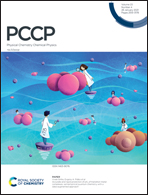Temperature and pressure-induced strains in anhydrous iron trifluoride polymorphs†
Abstract
Various structural configurations of iron trifluoride appear at the nanoscale and macroscopic size, either in the amorphous or crystalline state. The specific atomic organization in these structures crucially alters the performance of FeF3 as an effective cathode in Li-ion batteries. Our detailed first-principles computational simulations examine the structural strains induced by temperature and stress on the four anhydrous polymorphs observed so far in FeF3 at ambient pressure. A wealth of data covering previous experimental results on their equilibrium structures and extending their characterization with new static and isothermal equations of state is provided. We inform on how porous apertures associated with the six-octahedra rings of the HTB and pyrochlore phases are modified under compressive and expansive strains. A quasi-auxetic behavior at low pressures for the ground state rhombohedral phase is detected, which is in concordance with its anomalous structural anisotropy. In contrast with the effect of temperature, this structure undergoes under negative pressure phase transitions to the other three polymorphs, indicating potential conditions where low-density FeF3 could show a better performance in technological applications.



 Please wait while we load your content...
Please wait while we load your content...